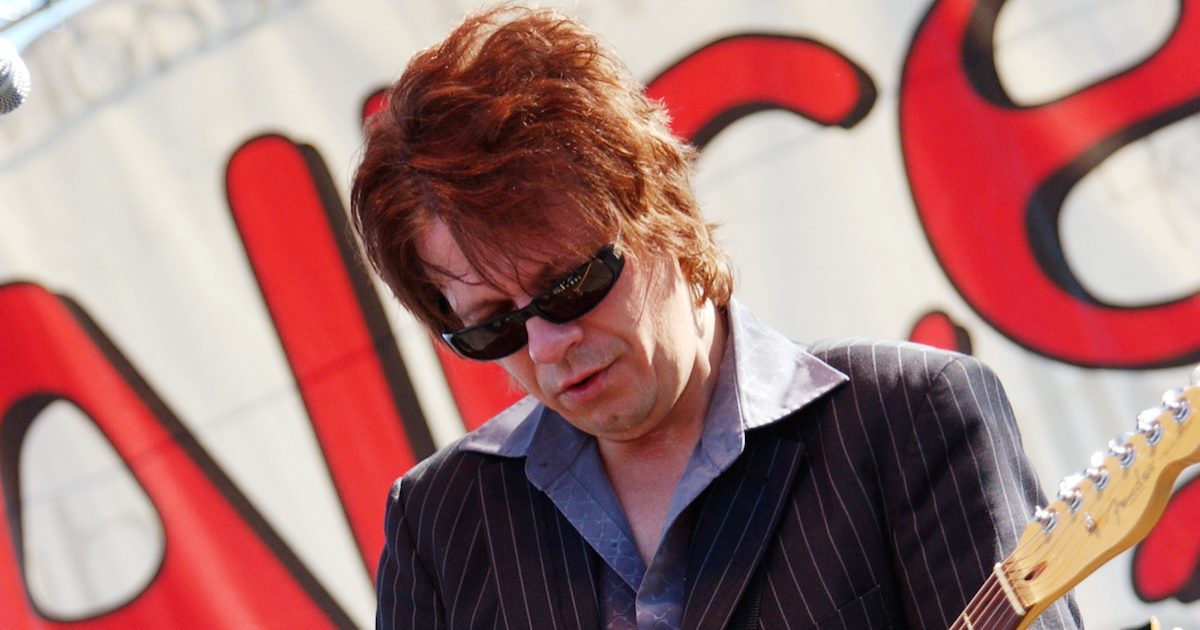New Advancements for Prostate Cancer
- Duran Duran guitarist Andy Taylor,who played guitar for the group between 1980 and 1986, as well as 2001 to 2006insists he’s not giving up on his cancer flight and hopes to inspire others to get checked early and prevent battling a stage four cancer like himself.
- Prostate cancer is the most common cancer in American men. Symptoms of prostate cancer are inconsistent and hard to pinpoint but may include changes in urinary function like urinating more or less often or waking up at night to go more than usual.
- There are several new drugs and treatment modalities available for those facing advanced-stage prostate cancer. You should speak with your oncologist to determine which might work for your specific case.
- SurvivorNetTV presents Music and Art: Reflecting On Your Journey, an episode from our original series SN & You that shares cancer survivors' stories about the importance of music and art during their cancer journey.
As the English new wave band's original guitaristwho played guitar for the group between 1980 and 1986, as well as 2001 to 2006insists he’s not giving up on his cancer flight, he hopes to inspire others to get checked early and prevent battling a stage four cancer like himself.
Read More
“As harsh as it is, it’s a death sentence. So you sort of walk out of the hospital in a stunned silence, because you could never be prepared for … you’ve got to start from the fact that it’s a slow burn, so it’s not going to take you quickly,” the determined father of four explained.
Taylor, who approaches the disease with optimism, noted how music plays a huge role during his cancer fight.
“Music’s never had a greater value to me,” he said. “One of the things that I learned early was, if you keep your mind active and you’re there and physically active, it really does [make a difference]. You’re carrying this grim reaper of a weight.”
The famed musician added, “If I could get a genie out of a bottle and make one wish, it’s that nobody ever has to go through what I went through. Duran have got a great female audience. Don’t just give him a poke, make him go get a PSA test!”

Taylor's Battle with Prostate Cancer
The musician shared his diagnosis given his absence from Duran Duran's Rock and Roll Hall of Fame induction ceremony in Los Angeles in November 2022.
His bandmates read a letter he'd written. In it, Taylor wrote:
"Just over four years ago, I was diagnosed with stage 4 metastatic prostate cancer."
He shared, "Many families have experienced the slow burn of this disease and of course we are no different; so I speak from the perspective of a family man but with profound humility to the band, the greatest fans a group could have and this exceptional accolade."
Taylor shared that his treatment had allowed him "until very recently" to "rock on" and live life somewhat normally. "Although my current condition is not immediately life-threatening, there is no cure," he wrote. "Recently, I was doing OK after some very sophisticated life-extending treatment, that was until a week or so ago when I suffered a setback, and despite the exceptional efforts of my team, I had to be honest in that both physically and mentally, I would be pushing my boundaries."
Understanding Prostate Cancer
Prostate cancer is the most common cancer in American men except for skin cancers. About one in eight men will be diagnosed with prostate cancer during his lifetime. The disease begins in the walnut-shaped prostate gland located between the rectum and bladder. This gland produces the fluid that nourishes sperm.
When Should I Get Tested for Prostate Cancer?
Symptoms of the disease are inconsistent and hard to pinpoint.
"Prostate cancer is a very odd disease in that it doesn't have a particular symptom," Dr. Edwin Posadas, director of translational oncology and the medical director of the Urologic Oncology Program at Cedars-Sinai, explained.
But changes in urinary function like urinating more or less often or waking up at night to go more than usual could be a sign of the disease. However, it's important to note that these potential symptoms could also could be caused by a urinary tract infection or even an enlargement of the prostate gland (which is not cancer).
There's No One Definitive Symptom for Prostate Cancer, But There Are Clues
Doctors that have spoken with SurvivorNet shared a hopeful outlook when considering a prostate cancer diagnosis because there are many treatment options, and there's been significant treatment progress over the past decade.
Surgical and radiation options, for example, have made improvements in reducing side effects of treatment while still providing excellent cure rates. Even for men with an advanced-stage diagnosis, many new options exist to treat prostate cancer and help them maintain an excellent quality of life.
Treating Late-Stage Prostate Cancer Like Andy Taylor’s: New Treatment Developments
We don't know too many details about Andy Taylor's prostate cancer battle, but we do know people with late-stage prostate cancer usually undergo some combination of treatments. And advancements in the treatment of late-stage prostate cancer are giving new hope to patients.
Treatment of late-stage prostate cancer, also called metastatic or stage IV prostate cancer, varies depending on your current health status and how aggressive the cancer appears. But new treatment advancements such as PARP inhibitors and new androgen deprivation drugs are making more options available.
According to Dr. Jeff Tosoian, a urologic oncologist at Vanderbilt University Medical Center, there are two primary situations in which you may be diagnosed with late-stage prostate cancer. First, there are those who have been treated for local prostate cancer and it recurs and spreads to other areas. "Or there are folks who never knew they had a localized prostate cancer and present with cancer, both in the prostate and in other places in the body," he says.
At this stage of the disease process, some treatments may be palliative to help relieve symptoms rather than curative therapies designed to stop or slow cancer growth. And while there is no known curative treatment available for stage IV prostate cancer, there are many drugs being investigated in clinical trials of prostate cancer patients with late-stage disease. These treatments will likely play a role in the future management of metastatic prostate cancer.
Targeted Therapy
Targeted therapy is a developing treatment option for prostate cancer. Unlike cytotoxic chemotherapy, which damages healthy cells, targeted therapies interfere with specific molecular pathways. These drugs can target and destroy specific cancer cells with fewer side effects than traditional chemotherapy.
Targeted therapy has three major mechanisms of action:
- Blocking the growth factor that encourages tumor cells to grow
- Interfering with the synthesis or function of DNA
- Disrupting cell signaling pathways essential for the survival and growth of cancer cells
PARP Inhibitors
PARP inhibitors work to stop the activity of poly (ADP-ribose) polymerase, a protein involved in DNA repair. In normal cells, PARP quickly repairs damaged DNA. In cancer cells, defective DNA cannot be repaired effectively when a patient is undergoing treatment without a PARP inhibitor. Without PARP to fix them, these breaks accumulate and cause cell death. Without PARP to fix breaks in DNA, DNA damage accumulates within cancer cells and causes cell death.
According to Dr. Mary K. O'Keeffe, a medical‌ ‌oncologist‌ ‌specializing‌ ‌in‌ ‌genitourinary oncology at‌ ‌NYU Langone Health's Perlmutter‌ ‌Cancer‌ ‌Center Long Island, two PARP inhibitors are currently FDA-approved to treat metastatic castration-resistant prostate cancer include:
- Lynparza (olaparib): A twice-daily oral pill given in combination with a gonadotropin-releasing hormone (GnRH)unless a bilateral orchiectomy (surgery to remove both testicles) has been done. The most common side effects include nausea, vomiting, fatigue, headaches, low white blood cell count, low red blood cell count (anemia), dizziness, and diarrhea.
- Rubraca (rucaparib): A twice-daily oral pill taken with or without food. Like Lynparza, Rubraca is given in combination with a gonadotropin-releasing hormone (GnRH)unless a bilateral orchiectomy (surgery to remove both testicles) has been done. Some of the most common side effects include nausea, vomiting, fatigue, low red blood cell count (anemia), abdominal pain, changes in bowel habits, and low platelets.
A 2021 study showed a positive result using combination therapy involving Lynparza (Olaparib) and an immunotherapy drug, Keytruda (pembrolizumab). While this is not an approved treatment at this time, it is a good example of new treatment options being developed.
Keytruda (pembrolizumab) and Lynparza (olaparib) combination therapy: Current trials investigating this drug combination for metastatic castration-resistant prostate cancer (mCRPC) show promising results, including a 58.6% reduction in target lesion size. Common side effects include anemia, nausea, fatigue, and loss of appetite.
Hormone Therapy
Hormone therapy is used when patients are unable to have cancer surgically removed because it has spread to other parts of the body. Although hormone therapies do not cure stage IV prostate cancer, they may help keep it from growing and spreading further. "The traditional standard of care for metastatic prostate cancer is androgen deprivation therapy, or hormone therapy," explains Dr. Tosoian.
When Is Hormonal Therapy Used to Treat Prostate Cancer?
Androgen deprivation therapy is a type of hormone therapy that works by inhibiting androgen production, including testosterone, or blocking androgen receptors which can slow down tumor growth.
"Prostate cancer feeds off testosterone," explains Dr. O'Keeffe. "When you lower testosterone with androgen deprivation therapy, it's no longer feeding the cancer."
As metastatic prostate cancer progresses, the cancer cells can adapt and become resistant to therapy. According to Dr. O'Keeffe, this is true for most cancer treatments. "You have some men that are on it for many years and some men can progress in less than a year if they have a more aggressive type of cancer."
Two newer androgen deprivation therapies for late-stage prostate cancer include:
- Xtandi (enzalutamide): FDA-approved to treat non-metastatic (nmCRPC) and metastatic castration-resistant prostate cancer (mCRPC) and metastatic castration-sensitive prostate cancer (mCSPC); It's a once-daily oral pill that can be taken with or without food. The most common side effects include fatigue, weakness, hot flashes, back pain, joint pain, changes in bowel habits, high blood pressure (hypertension), and decreased appetite.
- Erleada (apalutamide): FDA-approved to treat metastatic castrate-sensitive prostate cancer (mCRPC); It's a once-daily pill taken by mouth. The most common side effects include rash, hot flashes, high blood pressure, itching, and joint pain.
How Does Androgen Deprivation Therapy Help Shrink Prostate Cancer Tumors?
Bone Therapy
Metastatic cancer can destroy bone tissue and release substances that cause additional bone damage. Doctors often manage bone loss with treatment to stop or slow bone destruction (such as bisphosphonate drugs), reduce pain, and prevent fractures.
New drugs available to prevent bone loss and fractures in those whose cancer has already spread to the bones include:
Xgeva (denosumab): FDA-approved for preventing skeletal complications in men with advanced prostate cancer who are at high risk for fracture. It's an injection given under the skin every four weeks. The most common side effects include shortness of breath, fatigue, nausea, and low phosphate levels in your blood.
Other Treatment Options
Depending on the extent of disease, a person with late-stage prostate cancer will likely undergo some combination of treatments. Your care team might include doctors from different specialties, surgeons, medical oncologists, radiation oncologists, and nurses.
Other treatment options may include:
- Chemo: The goal of this therapy is not to cure prostate cancer, but rather to slow its growth and reduce symptoms.
- Radiation Therapy: This therapy uses high-energy rays or particles that are focused on prostate cancer cells to damage or destroy them. This treatment is effective for helping to ease symptoms related to prostate cancer, but it's not used as a cure.
- Surgery: Surgery isn't common in late-stage prostate cancer. However, sometimes, doctors may surgically remove the testicles (called an orchiectomy or surgical castration) in order to stop the production of testosterone.
- Clinical trials: Clinical trials are being conducted for many types of advanced prostate cancer. Participation may give you access to new drugs and treatments.
- Cancer vaccine: Provenge, an immunotherapy treatment given over the course of one month, is the first FDA-approved vaccine for metastatic castration-resistant prostate cancer (mCRPC). It helps your immune system attack prostate cancer cells that have been growing and dividing throughout the body. Common side effects include fatigue, chills, fever, back pain, nausea, joint pain, and headaches.
Discuss Treatment Options With Your Doctor
Although stage IV prostate cancer isn't curable, new treatment options are prolonging life and delaying the progression of the disease. With the latest therapies, many can live for years past diagnosis.
Discuss your treatment options with your care team and family. It's important to understand what treatments are available, how they work, and what to expect. Your doctor will tailor your therapy to meet your specific needs and discuss the benefits, risks, and side effects of each therapy.
Considering Chemotherapy For Advanced Prostate Cancer
Contributing: SurvivorNet Staff
Learn more about SurvivorNet's rigorous medical review process.


